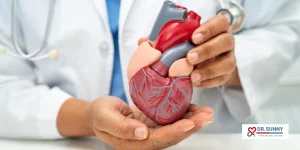Postural Orthostatic Tachycardia Syndrome (POTS) is a condition that affects the body’s ability to regulate blood flow and heart rate when moving from lying down to standing. For many, it can feel like their body simply “can’t keep up” when they change position — leading to dizziness, fatigue, brain fog, and even fainting spells.
While POTS has been recognized for decades, it has gained more public attention recently due to its connection with long COVID and other chronic health conditions. Understanding the condition, getting the right diagnosis, and having a personalized treatment plan are essential for improving quality of life.
If you live in Milton, Brampton, or Mississauga, local cardiologist Dr. Sunny Malhotra offers specialized evaluation and treatment for POTS, helping patients manage symptoms and regain stability in daily life.
What is Postural Orthostatic Tachycardia Syndrome (POTS)?
POTS is a form of dysautonomia, meaning it involves a dysfunction of the autonomic nervous system — the part of the nervous system that controls automatic functions like heart rate, blood pressure, and digestion.
In healthy individuals, standing up triggers subtle cardiovascular adjustments to keep blood circulating effectively. But in POTS, this regulation doesn’t happen as it should. Blood tends to pool in the lower half of the body, and the heart compensates by beating much faster than normal.
Key diagnostic marker:
- An increase in heart rate of 30+ beats per minute within 10 minutes of standing (or 40+ bpm in adolescents), without a significant drop in blood pressure.
What Causes POTS?
There’s no single cause of POTS, and in many cases, multiple factors may be involved. Some recognized types include:
- Neuropathic POTS – Involves nerve damage affecting the control of blood vessel constriction, leading to blood pooling in the legs.
- Hyperadrenergic POTS – Associated with high levels of stress hormones (like norepinephrine) that overly stimulate the cardiovascular system.
- Post-viral onset – Symptoms begin after a viral infection, including in some cases after COVID-19.
- Autoimmune-related POTS – Linked to conditions where the immune system mistakenly attacks the body’s own tissues.
- Connective tissue disorders – Such as Ehlers-Danlos syndrome, which can affect blood vessels and joints.
What Are the Symptoms?
POTS symptoms can vary from person to person, and they can range from mild to severely debilitating. Common symptoms include:
- Dizziness or lightheadedness upon standing (orthostatic intolerance)
- Rapid heartbeat (palpitations)
- Fatigue that worsens with physical or mental activity
- Brain fog — trouble focusing, remembering, or processing information
- Exercise intolerance — feeling unwell after even light activity
- Nausea or gastrointestinal discomfort
Because symptoms overlap with other conditions, some patients go years without a correct diagnosis.
How is POTS Diagnosed?
Diagnosis involves both a detailed patient history and objective testing. A cardiologist experienced with autonomic disorders will typically recommend:
- Comprehensive symptom history – Understanding when symptoms occur, their triggers, and any related medical history.
- Physical examination – Checking blood pressure, heart rate, and neurological function.
- Tilt-table test – A specialized test that measures changes in heart rate and blood pressure when moving from lying to standing.
- Active stand test – A simpler version of the tilt-table test performed in-office.
- Additional testing – Blood work, autonomic function tests, or screening for related conditions.
How is POTS Treated?
There’s currently no universal cure for POTS, but symptoms can often be managed effectively with a tailored approach. Treatment typically focuses on:
- Increasing blood volume – Through adequate hydration and increased salt intake (as recommended by a physician).
- Improving circulation – Wearing compression stockings to help prevent blood pooling in the legs.
- Physical reconditioning – Gradual, structured exercise programs that focus on building tolerance without triggering symptoms.
- Medications – Such as beta-blockers to slow heart rate, fludrocortisone to help the body retain salt and water, or midodrine to improve blood vessel constriction.
- Addressing underlying causes – Treating associated conditions like autoimmune disorders, Ehlers-Danlos syndrome, or post-viral complications.
Because POTS can present differently in each person, a one-size-fits-all approach doesn’t work — individualized care is key.
Why See a Cardiologist for POTS in Milton, Brampton, or Mississauga?
While POTS is a neurological and cardiovascular condition, its hallmark symptom — abnormal heart rate upon standing — makes cardiology expertise essential for proper evaluation and management.
Dr. Sunny Malhotra offers:
- Specialized expertise in autonomic disorders
- Individualized treatment plans based on patient needs and symptom patterns
- Access to advanced diagnostic tools like tilt-table testing
- Coordinated care with other specialists for related conditions
With the right evaluation, patients can move from uncertainty to understanding — and from simply coping to actively managing their symptoms.
Living with POTS
Living with POTS can be challenging, especially when symptoms interfere with work, school, or daily activities. But with the right diagnosis and treatment plan, many people see significant improvement in their quality of life.
If you live in Milton, Brampton, or Mississauga and are experiencing unexplained dizziness, rapid heart rate, or fatigue when standing, you don’t have to navigate this journey alone. Early intervention and specialized care can make a meaningful difference.
Take the Next Step
Don’t let POTS control your life. Contact Dr. Sunny Malhotra today to schedule a comprehensive evaluation and start your personalized care plan.



